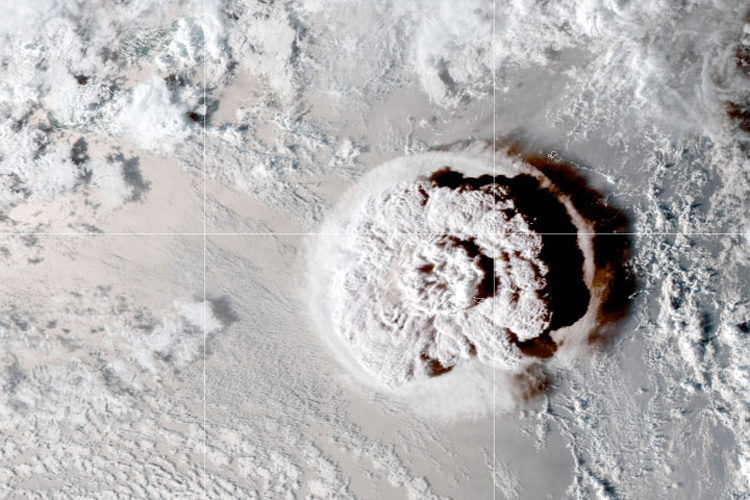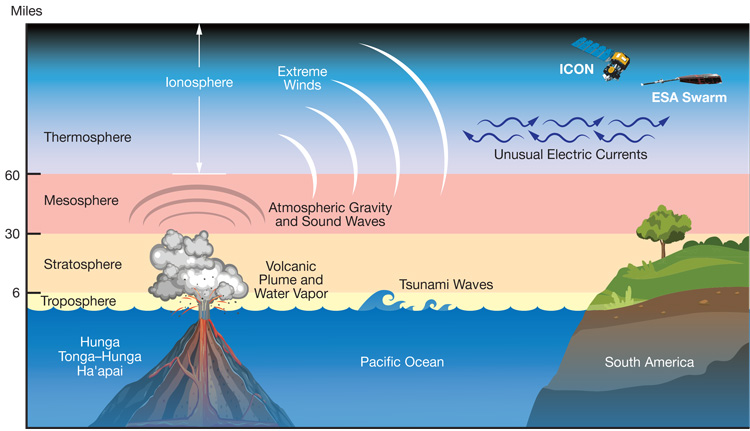Effects of January’s Tonga Eruption Felt at the Edge of Space

An underwater volcano that erupted in the South Pacific in January sent a 300-mile-wide plume of ash some 25 miles above the surface, generated a tsunami that injured and killed people thousands of miles away along the coasts of North and South America, produced a sonic boom that was heard 6,000 miles away in Alaska, and created atmospheric shock waves that circled Earth several times.
Scientists now report that the effects reached all the way into space, affecting electrical currents in the ionosphere above an altitude of 60 miles to some 190 miles above Earth’s surface.
The impact of the eruption on the ionosphere up to the edge of space were detected by two satellites, NASA’s Ionospheric Connection Explorer (ICON) — designed and operated by UC Berkeley physicists — and the European Space Agency’s Swarm satellites.
As reported today in the journal Geophysical Research Letters, the volcanic eruption on Jan. 15 generated hurricane-speed winds and unusual electric currents in the ionosphere, Earth’s electrified upper atmospheric layer at the edge of space. ICON’s main goal is to study the impact of storms and other atmospheric disturbances on the upper atmosphere as far as the edge of space.
“The volcano created one of the largest disturbances in space we’ve seen in the modern era,” said Brian Harding, a physicist at UC Berkeley’s Space Sciences Laboratory and lead author on a new paper discussing the findings. “It is allowing us to test the poorly understood connection between the lower atmosphere and space.”
The eruption of the Hunga Tonga-Hunga Ha‘apai volcano was the largest volcanic eruption since 1991’s Mt. Pinatubo in the Philippines. It destroyed most of an island — actually, the edge of the volcano’s caldera — that had been above the waves since 2015, leaving behind two remnant islands, Hunga Tonga and Hunga Ha’apai.

The underwater explosion pushed a giant plume of gases, water vapor and dust into the sky and created large pressure disturbances in the atmosphere, leading to strong winds. As the winds expanded upward into thinner atmospheric layers, they began moving faster. Upon reaching the ionosphere and the edge of space, ICON clocked the windspeeds at up to 450 miles per hour, making them the strongest winds below 120 miles altitude measured by the mission since its launch.
In the ionosphere, the extreme winds also affected electric currents. Particles in the ionosphere regularly form an east-flowing electric current — the equatorial electrojet — powered by winds in the lower atmosphere. After the eruption, the equatorial electrojet surged to five times its normal peak power and dramatically flipped direction, flowing westward for a short period. A strong equatorial electrojet is associated with redistribution of material in the ionosphere, which can disrupt GPS and radio signals that are transmitted through the region.
“It’s very surprising to see the electrojet be greatly reversed by something that happened on Earth’s surface,” said Joanne Wu, a Berkeley assistant physicist and co-author of the new study. “This is something we’ve only previously seen with strong geomagnetic storms, which are a form of weather in space caused by particles and radiation from the sun.”
